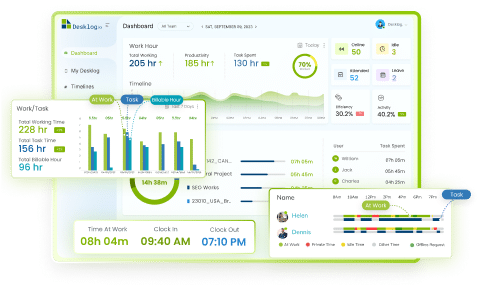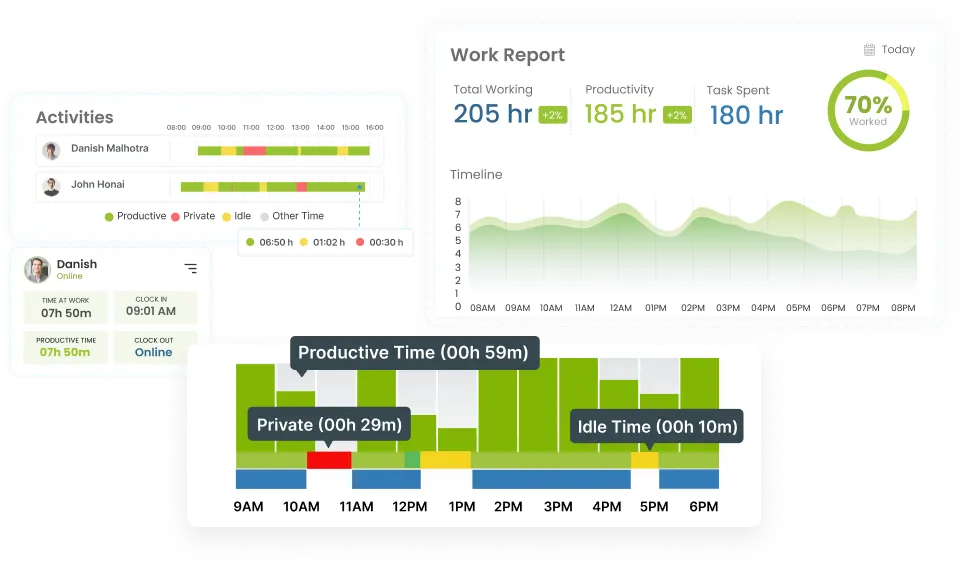Simply put, full-time equivalent is the total number of hours worked by an employee to meet the requirement for full-time status.
For example, let’s say a company considers 40 hours per week as full-time employment. If an employee works 40 hours per week, they are considered a full-time employee. However, if another employee works only 20 hours per week, they would be considered half-time.
Understanding FTE is like having a magic wand for managing your workforce in business and HR. Instead of just counting heads, FTE lets you see the real impact of your team’s hours which can be easily calculated and tracked automatically by a time tracking software.
Knowing FTE helps you plan staffing, budget smartly, and make fair decisions about benefits and compliance. It’s the key to unlocking the full potential of your team and your business.
What is Full Time Equivalent or FTE?
A full-time equivalent, often shortened to FTE, serves as a standard measure for employed individuals or students, allowing for comparison even if their weekly working hours vary.
Why do companies use FTE?
Companies use full-time equivalent (FTE) measurements because they provide a standardized way to evaluate and compare the workload and contributions of employees, even when their work hours vary.
This allows businesses to:
- Efficiently Allocate Resources: FTE helps companies allocate resources effectively by understanding the true capacity of their workforce. By converting part-time hours into FTE units, businesses can accurately assess staffing needs and avoid over or under-staffing situations.
- Budget Planning: FTE helps in budget planning by providing a clearer picture of labor costs. It allows companies to accurately forecast expenses related to salaries, benefits, and other workforce-related expenditures.
- Benefits Administration: FTE calculations are crucial for determining eligibility for benefits such as health insurance, retirement plans, and paid time off. By understanding FTE, companies can ensure fairness and consistency in benefits administration.
Key Terms Explained
- 1.0 FTE:
1.0 FTE represents a full-time equivalent, indicating that an employee works the standard full-time hours expected for a particular job or role.
- Variations in FTE Measurements:
FTE measurements can vary across different industries, countries, and even organizations within the same industry. While in some countries or industries, full-time employment might be defined as 40 hours per week, in others, it could be more or less. Additionally, some industries might have unique FTE calculations based on specific work patterns or regulatory requirements. Understanding these variations is crucial for accurate workforce management and compliance.
The Significance of FTE in Business
Why Does FTE Matter?
Companies use FTEs to figure out how much work their employees do. FTE plays a huge role in resource planning for companies across various industries.
Here’s how :
- FTE helps determine the optimal number of employees needed to fulfill operational requirements. By converting part-time and temporary positions into FTE units, businesses can accurately assess staffing needs and ensure sufficient coverage to meet demand without overstaffing.
- FTE calculations assist in budget planning by providing insights into labor costs. By knowing the FTE count, companies can estimate expenses related to salaries, benefits, training, and other workforce-related expenditures. This allows for more accurate budget forecasts and financial planning.
- FTE helps in balancing workloads among employees. By understanding the FTE capacity of each team member, managers can assign tasks more efficiently, ensuring that work is distributed evenly and deadlines are met without overburdening any individual.
- FTE analysis enables businesses to optimize resource allocation. By comparing FTE capacity with workload demands, companies can identify areas of overutilization or underutilization and make adjustments to maximize productivity and efficiency.
FTE influences hiring strategies. With FTE, you can figure out when to hire and whether a full time employee or a part time employee is required. This helps control costs and helps in better decision making.
Let’s dive in a little deeper on how FTE influences hiring strategies.
Here’s how :
- Budget Allocation:
FTE directly impacts budget allocation for staffing. Hiring full-time employees typically entails higher costs than other arrangements like part-time or contract workers. Therefore, organizations must carefully consider their FTE needs when planning their staffing budgets.
- Long-Term Planning:
FTE provides stability and continuity to the workforce. When organizations hire full-time employees, they are making a long-term commitment to those individuals, which affects strategic planning. Hiring full time employees suggests a commitment to sustained operations and growth, whereas relying heavily on temporary or contract workers may indicate a more flexible or project-based approach.
- Employee Benefits and Perks:
Full-time employees are often eligible for a broader range of benefits and perks compared to part-time or contract workers. These benefits may include health insurance, retirement plans, paid time off, and professional development opportunities. Therefore, organizations must consider the cost and availability of benefits when deciding on their FTE ratio.
- Workforce Flexibility:
While hiring full-time employees provides stability, it can also reduce workforce flexibility. Organizations with a high FTE ratio may find it challenging to adjust staffing levels quickly in response to fluctuating demand or changing business conditions. In contrast, maintaining a balance between full-time and part-time or contract workers allows for greater flexibility in scaling the workforce up or down as needed.
- Skill Acquisition and Retention:
FTE hiring strategies often focus on acquiring and retaining specialized skills critical to the organization’s success. By offering full-time positions with competitive salaries and opportunities for career advancement, organizations can attract top talent and encourage employee loyalty and commitment.
- Organizational Culture and Engagement:
Full-time employees typically have a deeper sense of belonging and engagement with the organization compared to temporary or contract workers. Therefore, FTE hiring strategies play a crucial role in shaping organizational culture and fostering a sense of community among employees.
Case Study : Amazon
Note : While this example does not represent a specific case study, it just illustrates how companies like Amazon leverage FTE principles to drive workforce planning, optimize operations, and deliver superior customer experiences.
Background : Amazon operates a vast network of fulfillment centers and distribution facilities worldwide. With complex logistics operations and high-volume order fulfillment requirements, Amazon relies on strategic FTE planning to manage its workforce effectively.
FTE Application : Since Amazon has a lot of full time, part time and remote employees, they employ advanced workforce management technologies that utilize FTE calculations to optimize staffing levels and workflow efficiency within its fulfillment centers. By analyzing factors such as order volumes, inventory levels, and processing times, Amazon can determine the optimal number of FTE positions needed to meet customer demand.
Implementation : Amazon’s FTE-based workforce planning allows the company to adjust staffing levels in real-time based on fluctuations in order volumes and operational priorities. The company leverages FTE calculations to schedule shifts, assign tasks, and allocate resources within its fulfillment centers, ensuring timely order processing and delivery.
Results : Amazon’s strategic use of FTE planning has contributed to several key outcomes:
- Scalable operations: FTE-based workforce planning enables Amazon to scale its workforce up or down rapidly in response to changing demand, seasonal fluctuations, and peak shopping periods.
- Efficient order fulfillment: By optimizing staffing levels and workflow processes, Amazon can fulfill orders quickly and accurately, meeting customer expectations for fast delivery and service.
- Cost-effective resource allocation: FTE calculations help Amazon minimize labor costs and maximize productivity within its fulfillment centers, supporting the company’s commitment to operational efficiency and profitability.
FTE Calculation Methods
Calculating Full-Time Equivalent (FTE) is crucial for organizations to assess their workforce capacity accurately.
But to calculate FTE, you need to know the working hours and this can be easily tracked by a time tracking software which tracks offline time and idle time. Additionally, there are a lot of benefits of using time tracking software like project time tracking. You can also track project profit and loss which is very essential for the stability of an organization. Choose the best time tracking software for your needs.
There are different methods for calculating FTE, depending on the organization’s needs and the complexity of its workforce.
Below is a step-by-step guide to two common FTE calculation methods, along with an example calculation to illustrate the process.
Method 1: Simple FTE Calculation
Step 1: Define Full-Time Equivalent (FTE)
- FTE represents the total hours worked by all employees, expressed as the equivalent of a full-time employee working standard hours.
Step 2: Determine Standard Hours
- Establish the standard number of hours worked by a full-time employee per week or month. Typically, this is 40 hours per week or 160 hours per month.
Step 3: Calculate FTE for Each Employee
- For each employee, divide the total hours worked by the standard number of hours for a full-time employee.
- FTE = Total hours worked / Standard hours for full-time
Step 4: Sum FTE for All Employees
- Sum the FTE values calculated for each employee to determine the total FTE for the organization or department.
Method 2: Weighted FTE Calculation
Step 1: Define Full-Time Equivalent (FTE)
- Same as in Method 1.
Step 2: Determine Weighted Hours
- Assign weightings to different types of work hours based on their impact or importance. For example, regular hours may have a weight of 1.0, overtime hours 1.5, and vacation hours 0.5.
Step 3: Calculate Weighted FTE for Each Employee
- For each employee, multiply the total hours worked in each category (regular, overtime, vacation, etc.) by the respective weightings.
- Then, sum these weighted hours and divide by the standard number of hours for a full-time employee to calculate the weighted FTE.
Step 4: Sum Weighted FTE for All Employees
- Sum the weighted FTE values calculated for each employee to determine the total weighted FTE for the organization or department.
Example Calculation
Scenario:
- Company X has three employees:
- Employee A worked 160 regular hours and 20 vacation hours.
- Employee B worked 140 regular hours and 10 overtime hours.
- Employee C worked 180 regular hours and 15 vacation hours.
Method 1: Simple FTE Calculation
- Standard hours for full-time = 160 hours
- FTE for each employee:
- Employee A: 180 hours / 160 hours = 1.125 FTE
- Employee B: (140 hours + 10 hours) / 160 hours = 0.9375 FTE
- Employee C: 195 hours / 160 hours = 1.21875 FTE
- Total FTE = 1.125 + 0.9375 + 1.21875 = 3.28125 FTE
Method 2: Weighted FTE Calculation
- Weightings:
- Regular hours: 1.0
- Overtime hours: 1.5
- Vacation hours: 0.5
- Weighted FTE for each employee:
- Employee A: (160 hours * 1.0) + (20 hours * 0.5) = 160 + 10 = 170 weighted hours
- Employee B: (140 hours * 1.0) + (10 hours * 1.5) = 140 + 15 = 155 weighted hours
- Employee C: (180 hours * 1.0) + (15 hours * 0.5) = 180 + 7.5 = 187.5 weighted hours
- Total weighted FTE = (170 + 155 + 187.5) / 160 = 1.4296875 FTE
Using a Full-Time Equivalent Calculator
Utilizing digital tools for Full-Time Equivalent (FTE) calculation offers several advantages, making the process more efficient, accurate, and accessible.
Here are the benefits of using digital tools for FTE calculation:
- Efficiency:
FTE calculators automate the calculation process, saving time and effort compared to manual calculations. With just a few inputs, users can obtain FTE values quickly, allowing them to focus on other critical tasks.
- Accuracy:
Digital FTE calculators minimize the risk of human error associated with manual calculations. By following predefined algorithms, these tools ensure consistency and precision in FTE calculations, reducing the likelihood of mistakes.
- Flexibility:
Online FTE calculators often offer customizable options to accommodate various workforce structures, including different types of work hours, employee classifications, and organizational preferences. Users can adjust parameters to reflect specific scenarios accurately.
- Accessibility:
Digital FTE calculators are accessible from any device with internet connectivity, enabling users to perform calculations anytime, anywhere. This accessibility facilitates collaboration among team members and allows for quick adjustments based on real-time data.
- Visualization:
Some FTE calculators provide visualizations, such as charts or graphs, to help users interpret and analyze FTE data more effectively. These visual representations enhance understanding and facilitate decision-making regarding workforce planning and resource allocation.
Recommended Full-Time Equivalent Calculators Available Online
- ADP FTE Calculator:
The calculator offers customization options and generates detailed reports for analysis.
- Gusto FTE Calculator:
The calculator helps small businesses and startups manage their workforce effectively.
- Paychex FTE Calculator:
Paychex offers an FTE calculator as part of its suite of payroll and HR solutions. The calculator simplifies FTE calculations for businesses of all sizes and provides insights to support strategic workforce planning.
- Bambee FTE Calculator:
The calculator helps businesses ensure compliance with labor regulations and optimize staffing levels.
- Zenefits FTE Calculator:
Zenefits offers an FTE calculator as part of its HR software platform. The calculator provides customizable options for calculating FTE values and supports efficient workforce management practices.
Common Mistakes in FTE Calculation
Common mistakes in FTE calculation include:
- Ignoring part-time employees: Failing to include part-time workers or calculating their FTE incorrectly can lead to understated workforce capacity.
- Omitting paid time off: Excluding vacation, sick leave, or other paid time off from FTE calculations can result in inflated FTE values and inaccurate workforce assessments. Incorrect standard hours: Using an inaccurate standard for full-time hours (e.g., 35 hours instead of 40) can skew FTE calculations and misrepresent workforce capacity.
- To avoid these errors, ensure all employees, including part-time workers, are accounted for accurately. Include all paid time off in calculations and use the correct standard for full-time hours. Regularly review and verify FTE calculations for accuracy.
FTE Calculation Variants
Different Approaches to Calculating FTE
Various FTE formulas accommodate different timeframes and employee types. For weekly calculations, FTE equals total hours worked divided by standard weekly hours (e.g., 40 hours). Monthly FTE is total hours divided by standard monthly hours (e.g., 160 hours). Yearly FTE divides total hours by standard yearly hours (e.g., 2,080 hours). Part-time and seasonal workers contribute to FTE by calculating their hours worked as a proportion of full-time hours. For example, if a part-time employee works 20 hours per week and standard full-time hours are 40, their FTE would be 0.5. Similarly, seasonal workers’ hours are prorated based on their duration of employment.
Industry-Specific FTE Calculations
In education, FTE calculations may consider instructional hours, student-teacher ratios, and classroom capacity. In healthcare, FTE calculations often revolve around patient-to-staff ratios, bed occupancy rates, and clinical workload. Each industry tailors FTE calculations to align with its unique operational needs, service demands, and regulatory requirements.
Compliance Issues
Legal rules are important when calculating Full-Time Equivalent (FTE), making sure companies follow labor laws and industry standards. Key global rules affecting FTE include the Fair Labor Standards Act (FLSA), laws on working conditions, healthcare rules, union deals, tax and benefits laws, and data privacy rules. Complying with these rules prevents fines and legal trouble. Employers must calculate FTE accurately to determine things like overtime pay and staffing needs. Staying up-to-date on laws, getting legal advice, and having clear processes are crucial to ensure FTE calculations are legal and fair to workers while following the rules.
Strategic Uses of FTE Information
Businesses strategically leverage Full-Time Equivalent (FTE) data for:
- Workforce Planning: Determining staffing levels and resource allocation efficiently.
- Budgeting: Guiding financial decisions and optimizing labor costs.
- Operational Efficiency: Assessing productivity and improving performance.
- Talent Management: Identifying talent, addressing skill gaps, and planning for succession.
- Compliance and Risk Management: Ensuring adherence to labor laws and minimizing legal risks.
Integration of FTE data with workforce analytics enhances strategic decision-making, providing insights into workforce dynamics, trends, and performance metrics for effective planning and execution.
Challenges in FTE Management
Managing Full-Time Equivalent (FTE) figures effectively can present several challenges, including:
- Complex Workforce Structures: Managing FTE becomes challenging in organizations with diverse workforce structures, including part-time, temporary, and remote workers.
- Data Accuracy: Ensuring accurate data collection and verification processes is essential to prevent errors in FTE calculations.
- Changing Workforce Needs: Adapting FTE calculations to accommodate fluctuating workforce demands, such as seasonal variations or project-based staffing, can be challenging.
- Regulatory Compliance: Staying compliant with labor laws, union agreements, and industry regulations requires careful consideration in FTE management.
- Integration with Systems: Integrating FTE data with HR, payroll, and other systems can be complex, requiring seamless data exchange and synchronization.
To address these challenges, organizations can implement solutions such as:
- Utilizing automated FTE calculation tools to streamline the process and minimize errors.
- Establishing clear policies and procedures for data collection, validation, and reporting.
- Implementing workforce planning strategies that consider changing business needs and workforce dynamics.
- Investing in training and development programs to ensure staff understand FTE calculations and compliance requirements.
- Leveraging technology solutions that integrate FTE data with other systems for improved accuracy and efficiency.
It’s not just about numbers; it’s about leveraging FTE data to craft strategic masterstrokes in workforce planning, budgeting, and talent management. Yet, like any adventure, our path is not without challenges.
But fear not! Armed with solutions like automated tools and clear policies, we can conquer these obstacles. I urge you to use these methods to boost success and innovation in your business strategies, ensuring growth and sustainability in today’s ever-changing business world.
FAQ
1. What are the difference between Headcount and FTE:
Headcount: Refers to the total number of employees in an organization, regardless of their employment status or the number of hours they work.
FTE (Full-Time Equivalent): Represents the total number of hours worked by all employees, converted into the equivalent of full-time employees based on standard hours (e.g., 40 hours per week).
2. Effect of Changes in Employee Hours on FTE:
Changes in employee hours directly impact FTE calculations. For example:
- Increasing employee hours increases FTE, as more hours are worked.
- Decreasing employee hours reduces FTE, as fewer hours are worked.
- Converting part-time employees to full-time increases FTE, as they now contribute more hours to the total.
3. Can FTE be a Fraction?
Yes, FTE can be a fraction. It represents the portion of full-time hours worked by an employee. For example:
- A part-time employee working 20 hours per week in a 40-hour workweek has an FTE of 0.5.
- A full-time employee working 32 hours per week in a 40-hour workweek has an FTE of 0.8.
4. How is FTE used in budgeting?
FTE is used in budgeting to estimate labor costs, allocate resources, and determine staffing needs based on workforce capacity.
5. What factors should be considered in FTE calculations?
Factors such as regular hours worked, overtime hours, paid time off, and employee classifications (full-time, part-time) should be considered in FTE calculations.
6. Are contractors included in FTE calculations?
Contractors may or may not be included in FTE calculations, depending on their classification and the organization’s policies. Generally, contractors are not counted as FTEs unless they are considered equivalent to full-time employees.
7. How often should FTE calculations be updated?
FTE calculations should be updated regularly to reflect changes in employee hours, staffing levels, and business needs. This could be done monthly, quarterly, or annually, depending on the organization’s requirements.

















